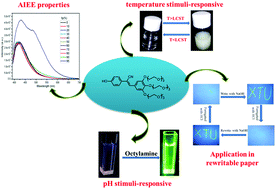Multistimuli-responsive small-molecule compound with aggregation-induced emission enhancement characteristics: preparation, properties and applications
Abstract
A novel multifunction luminescent small-molecule compound with hydrophilic chains was successfully designed and synthesized, which exhibited aggregation-induced emission enhancement (AIEE) characteristics. Even more interesting, it exhibited responsive behavior to temperature, pH and UV irradiation. In aqueous solution, its luminescence intensity showed temperature sensitivity. Initially, its luminescence intensity decreased slightly with an increase in temperature, which was enhanced greatly when the temperature increased to its lower critical solution temperature (LCST). With a further increase in temperature, there was a significant decline in its luminescence intensity. Additionally, it showed different pH and UV irradiation responsive behaviors in water and THF solution. In THF solution, its luminescence intensity was enhanced greatly with the addition of alkali, but it decreased with an increase in UV irradiation time. In aqueous solution, its luminescence intensity was enhanced slightly and its LCST decreased first and then increased with the addition of alkali. However, its luminescence intensity increased with an increase in UV irradiation time. The prepared small-molecule compound could also be used as a rewritable material with solid alkali or alkali solution used as ink and ordinary paper adsorbed with our prepared small-molecule compound used as rewritable paper.



 Please wait while we load your content...
Please wait while we load your content...